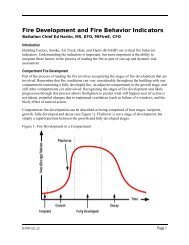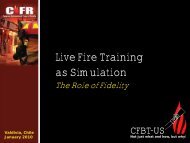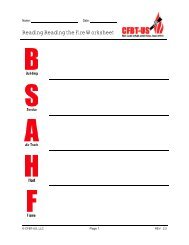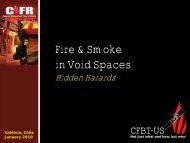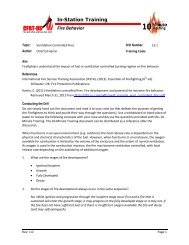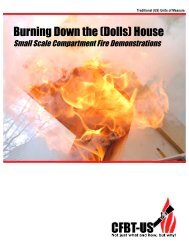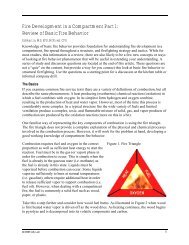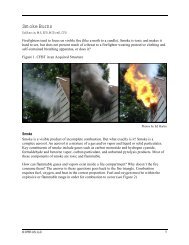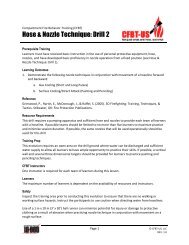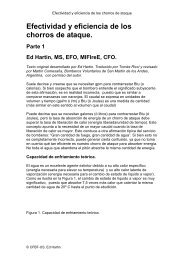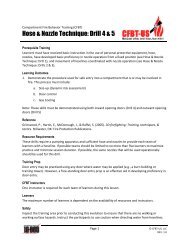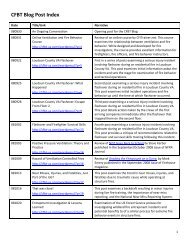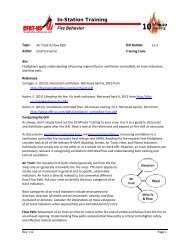CFBT INSTRUCTOR COURSE INFORMATION SHEET ... - CFBT-US!
CFBT INSTRUCTOR COURSE INFORMATION SHEET ... - CFBT-US!
CFBT INSTRUCTOR COURSE INFORMATION SHEET ... - CFBT-US!
You also want an ePaper? Increase the reach of your titles
YUMPU automatically turns print PDFs into web optimized ePapers that Google loves.
<strong>CFBT</strong> <strong>INSTRUCTOR</strong> - <strong>COURSE</strong> <strong>INFORMATION</strong> <strong>SHEET</strong><br />
• Identify the responsibilities of the instructor-in-charge when conducting live fire training in a<br />
purpose built prop or burn building.<br />
Fire Attack 3 (Live Fire)<br />
Participants understand how to conduct the Fire Attack 3 evolution. Developing competence in<br />
conducting this evolution will require coached practice.<br />
• Understand the <strong>CFBT</strong>-<strong>US</strong> standard operating guidelines applicable to conducting Fire Attack 3.<br />
• Identify the potential problems that might occur while conducting Fire Attack 3 and the<br />
appropriate methods for resolving these problems.<br />
• Identify the procedure used to inspect the demo/attack cell prior to use.<br />
• Recognize the required elements of a pre-training safety and instructional briefing and walk<br />
through of the prop used for live fire training.<br />
• Describe the participant learning outcomes for Fire Attack 3.<br />
• Explain how the instructor maintains appropriate fire conditions for the duration of Fire Attack 3.<br />
• Demonstrate proficiency in door entry procedures under live fire conditions.<br />
• Demonstrate proficiency in gas cooling while advancing and retreating and surface cooling<br />
techniques under live fire conditions.<br />
• Describe the advantages and disadvantages of verbal and non-verbal instructional styles for<br />
conducting Fire Attack 3.<br />
• Explain the post-training debriefing process with particular emphasis on the use of questions to<br />
enhance participant learning.<br />
Team Case Study Presentations (Out-of-Class & Classroom)<br />
Participants recognize the hazards presented by live fire training and the steps necessary to mitigate or<br />
reduce the risks involved.<br />
• Analyze a live fire training LODD case study with regards to compliance with applicable<br />
regulations and standards.<br />
• Identify the influence of the level of fire behavior knowledge of the participants on situational<br />
awareness and decision-making.<br />
• Analyze a case study involving a live fire training line-of-duty death (LODD) to determine causal<br />
factors and identify appropriate risk management action steps.<br />
<strong>CFBT</strong> & Acquired Structures (Classroom)<br />
Participants understand the hazards presented, regulatory and standards requirements, and risk<br />
management strategies used when conducting live fire training in acquired structures.<br />
Note: This course does not substantively address live fire training in acquired structures. However, it is<br />
incumbent on <strong>CFBT</strong> instructors to have an understanding of this type of training.<br />
• Explain the general provisions of NFPA 1403 that are applicable to <strong>CFBT</strong> in acquires structures<br />
and how they differ from those applicable to training in purpose built props and burn buildings.<br />
© <strong>CFBT</strong>-<strong>US</strong>,LLC Page 10 REV: 2.0<br />
www.cfbt-us.com 10/12/08




